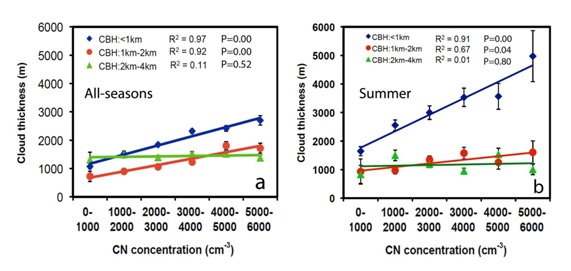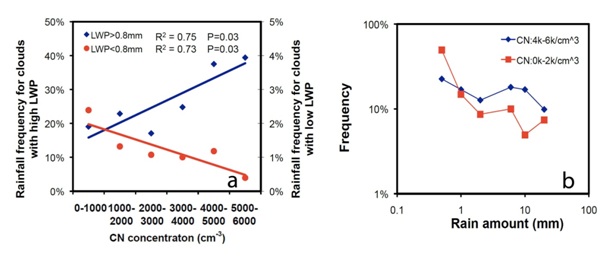The Long-Term Impacts of Aerosols on the Vertical Development of Clouds and Precipitation
Submitter:
Li, Zhanqing — University of Maryland
Area of research:
Cloud-Aerosol-Precipitation Interactions
Journal Reference:
Science
Aerosols—tiny particles in the air, like dust or soot—can affect clouds and precipitation by serving as cloud condensation nuclei (CCN), altering cloud microphysics and precipitation processes and modulating radiative and latent energy to change atmospheric dynamics and thermodynamics that dictate cloud development. These effects can either suppress or foster cloud and precipitation processes. Various effects have been studied for individual cases under highly constrained conditions, but little has been done to decipher long-term effects under general conditions.
Impact
Using 10-year extensive measurements made at the Department of Energy’s Atmospheric Radiation Measurement (ARM) Climate Research Facility in the U.S. Southern Great Plains, researchers found unprecedented strong evidence that aerosols can drastically alter cloud and precipitation. Yet, various effects are sorted out under different meteorological and cloud conditions. Cloud-top height and thickness are found to increase—most significantly in summer by up to a factor of 2—with increased aerosol concentration measured near the ground, for clouds with warm base (above 15°C) and mixed-phase tops (below -4°C). However, few changes are found for clouds with no ice or with high cloud bases. The precipitation frequency increases with aerosols for deep clouds of high water content and decreases for clouds of little water. The observational findings are successfully reproduced with a state-of-the-art cloud-resolving model.
Summary
These findings have significant implications to understanding anthropogenic (manmade) influences on water resources, on Earth’s climate and its changes, and for making sound policies to sustain economic development. Because economic development is often accompanied by increases in aerosol emissions, the findings imply a severe adverse impact on sustainable development, especially over regions vulnerable to extreme meteorological events like drought or flooding. Increases in aerosol or pollution in general tend to polarize precipitation, making dry places drier and moist regions wetter, and thus reduce water usage efficiency, a key factor for life and agriculture. In light of the broad implications, the findings of the study were reported by thousands of media around the world in different languages.



